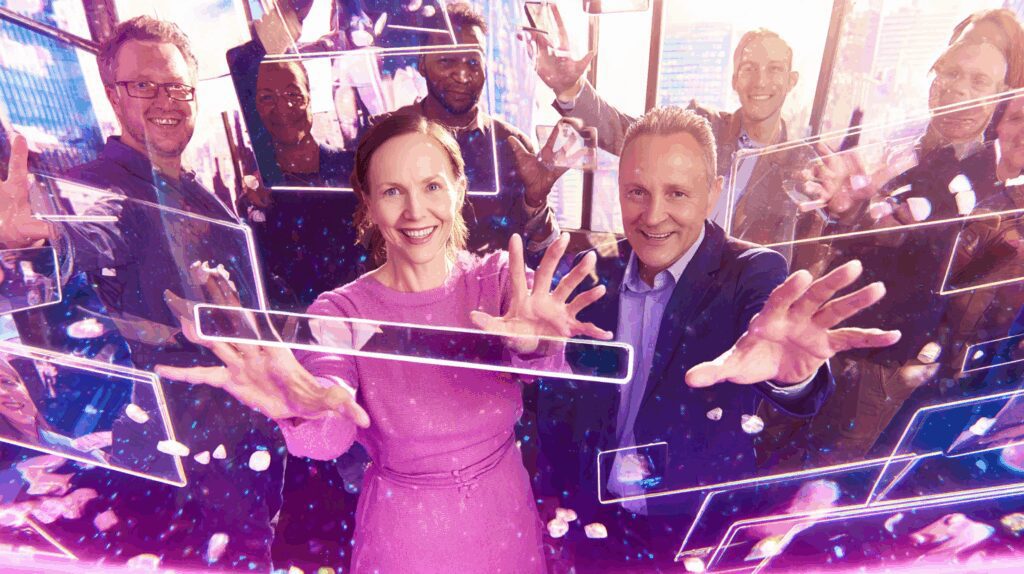In 2025, video marketing is changing, driven by technological advances and growing consumer expectations. These transformations offer unique opportunities to stand out, provided you master the new practices. At Moovizzwe integrate these trends into our solutions to help our customers create high-impact campaigns adapted to tomorrow's challenges. Here are the 5 major axes to adopt right now.
1. Short videos: a kingly but demanding format
With focus times kept to a minimum, short videos (15 to 60 seconds) dominate platforms such as TikTok, Instagram Reels and YouTube Shorts. According to a study by HubSpot, 89% of marketers who already produce short videos plan to maintain or increase their investment this year. Why do they plan to do so?Because73% of users surveyed prefer to learn more about a product or service from a short video.
Why does it work?
- Snackable effect: Ideal for quick, on-the-go consumption.
- Algorithmic boost: These formats are favored by platforms, increasing their organic visibility.
- Immediate impact: A clear, concise narrative grabs attention.
Case in point:
Netflix has harnessed the power of short videos to promote its content on TikTok. By broadcasting teasers lasting less than 60 seconds, the platform has created a buzz around its series and films, such as "Wednesday" and "Stranger Things", by adapting to the codes and expectations of the platform's users.
- Adapting to the platform: Videos are based on TikTok trends (popular music, dynamic editing) to maximize their impact.
- Implicit call to action: Teasers intrigue just enough to entice users to watch the full series on Netflix.
- Community engagement: Netflix encourages its subscribers to participate with challenges or memes based on their content (e.g. "Wednesday" choreography), creating a virtuous circle of organic interaction.
2. Artificial intelligence at the heart of personalization
Artificial intelligence is disrupting video creation by introducing unprecedented possibilities for personalization and optimization. By 2025, companies that leverage AI to adapt their content in real time will surpass those that stick to static campaigns.
Practical applications of AI :
- Dynamic personalization: Video ads that adapt to user preferences (location, interests, browsing history).
- Artistic and differentiating results: The use of AI-generated images creates a unique and memorable visual universe, reinforcing a brand's positioning as innovative and daring.
- Digital avatar creation: Create professional videos without filming, thanks to animated avatars that embody your message.
- Automated optimization: real-time analysis of performance to adjust creative elements (titles, colors, music).
Artificial intelligence is transforming video and visual creation, enabling unprecedented levels of personalization and innovation. In 2025, its use will no longer be limited to automating tasks, but will become a genuine creative and strategic lever.
Example: Undiz and the use of AI for an advertising campaign
In 2023, agency Cowboys collaborated with French underwear brand Undiz on an innovative OOH campaign. The visuals for the models and environments were entirely generated using MidJourney's AI, while the products - swimwear - were real photos. The campaign stood out for its deliberately dreamlike and intriguing aesthetic, exploiting AI to enhance the artificial aspect of the visuals.
3. Interactive videos: turning audiences into players
Interactive videos represent a revolution in engagement. By integrating interactive functionalities (clicks, choices, integrated purchases), they increase not only viewer involvement but also conversions.
Why interactive videos are a hit :
- Increased immersion: the user becomes an actor in the story.
- Memorization rate: An interactive experience is better remembered than passive content.
- Ease of action: Buy or book an appointment directly from the video.
Case in point:
In 2021, Coca-Cola launched an innovative campaign on Snapchat, harnessing augmented reality to deliver a memorable, interactive experience. Thanks to a "Face Lens", users could create their own beatboxes using iconic brand sounds, such as the famous "Tschhhhh" or "Yeah". Each interaction was transformed into a unique musical creation.
At the same time, Coca-Cola was the first advertiser in France to take advantage of Snapchat's Spotlight feature, a platform dedicated to viral videos. Users were encouraged to share their musical compositions on Spotlight, generating natural virality and amplifying the campaign's impact.
This project aimed to strengthen the engagement of young consumers by blending technological innovation and pop culture, while highlighting Coca-Cola's sound identity. This initiative is a perfect example of how brands can use augmented reality and social networks to create immersive, unifying experiences, while capturing the attention of audiences on popular platforms.
4. Authentic storytelling: a response to digital saturation
In a world saturated with advertising content, storytelling has become an essential strategic lever. Consumers, weary of conventional promotional pitches, are looking for authentic narratives that resonate with their values and emotions. Well-crafted storytelling doesn't just tell a story: it puts your audience at the heart of the narrative, while highlighting your mission and values.
The keys to powerful storytelling
- Emotion and transparency: human stories touch more deeply. Whether it's a challenge overcome, a transformation or a moment of wonder, authenticity is essential.
- Audience focus: Consumers need to see themselves in the story. Highlight challenges or aspirations they can relate to.
- Narrative structure: A captivating introduction, engaging development and memorable conclusion guarantee lasting impact.
Case in point:
In 2023, IKEA launched the "Life under your roof" campaign , highlighting everyday moments experienced by families in their homes. This series of advertisements illustrates how IKEA products integrate harmoniously into the lives of its customers, facilitating interaction and improving domestic comfort.
Why is this campaign a model of storytelling?
- Closeness to everyday life: IKEA focuses on familiar situations, reflecting the challenges and joys of life at home. This approach creates a strong emotional connection with the public, who recognize themselves in these authentic scenes.
- Humor and accessibility: The campaign uses a light, humorous tone, making the messages memorable and enjoyable. This strategy reinforces IKEA's image as a brand that is close to its customers, offering practical and affordable solutions.
- Product showcasing: The ads demonstrate how IKEA furniture and accessories meet the real needs of families, while adapting to different lifestyles and spaces.
Results :
- Increased engagement: The campaign generated strong interaction on social networks, with many positive comments and shares, testifying to the emotional impact of the ads.
- Strengthening loyalty: By highlighting everyday situations, IKEA has consolidated its position as a brand that is attentive to its customers' needs, thereby strengthening customer loyalty.
5. Immersive videos: 3D for advertising engagement
In 2025, immersive 3D videos are emerging as a powerful lever for creating memorable experiences and capturing attention. 3D technology, combined with hyper-realistic rendering, makes it possible to design innovative ads that push the limits of reality, while remaining accessible to a wide audience.
Why is 3D revolutionizing advertising?
- Visual immersion: 3D renderings immerse viewers in a creative universe where every detail is designed to impress.
- Creative flexibility: 3D can bring to life concepts that would be impossible to realize with traditional photography, opening up an unlimited field for the imagination.
- Adaptability: Whether for TV commercials, the web or augmented reality, 3D adapts to all formats and media.
In 2021, Paco Rabanne launched Phantom, a fragrance for men embodying innovation and modernity. The associated advertising campaign stands out for its bold use of 3D and special effects, creating a captivating retro-futuristic universe.
This campaign for Paco Rabanne's Phantom fragrance is a model of 3D advertising, thanks to its immersive retro-futuristic universe, where humans and robots coexist in a spectacular party. The setting perfectly illustrates the brand's avant-garde spirit. The 3D elements, such as the robot-shaped bottle, blend seamlessly into the visual ensemble, reinforcing the product's identity. With dynamic transitions and captivating animations, the visual narrative maintains the viewer's attention, making this ad both memorable and engaging.
In terms of impact, the campaign stood out for its unique aesthetic in a highly competitive market, immediately attracting eyeballs and interest. It also reinforced Paco Rabanne's image as an innovator, appealing to a clientele in search of modernity and audacity.
Make video your strategic asset with Moovizz
These trends are redefining video marketing expectations and opening up unique perspectives for brands ready to innovate. At Moovizz, we combine creativity, technological expertise and mastery of new tools to help you take advantage of these developments.
Contact us today to discuss your needs and turn your ideas into eye-catching video campaigns.
Shall we get down to business?
Ready to make a difference? Contact us today to turn your ideas into high-performance, engaging video campaigns. Simply fill in this form and we'll get back to you:



